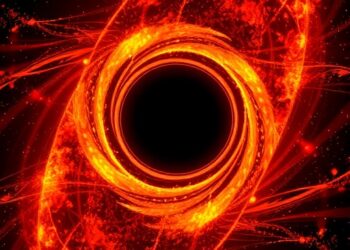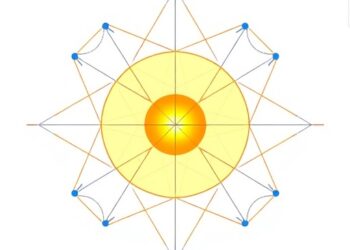Black Holes Sing a New Tune: Unraveling the Cosmic Symphony of Rotation and Thermodynamics
In a groundbreaking fusion of theoretical physics and astronomical observation, a recent study published in the European Physical Journal C has unveiled a profound new understanding of rotating black holes, positing that their thermodynamic behavior can be illuminated by a subtle yet crucial local characteristic: Kiselev-type behavior. This research, spearheaded by V.G. Czinner and H. Iguchi, delves into the enigmatic quantum realm surrounding these cosmic behemoths, offering a fresh perspective on their fundamental properties and challenging existing paradigms. The work, titled “Hawking–Rényi thermodynamics of rotating black holes from locally Kiselev-type behavior,” not only expands our theoretical toolkit but also hints at observational avenues that could verifiably confirm its predictions, potentially ushering in an era of precision cosmology centered around these gravitational titans. The paper’s authors propose that by examining the localized environmental conditions – specifically, how matter and radiation interact in the immediate vicinity of a rotating black hole – we can gain unprecedented insights into its thermodynamic equilibrium, something previously thought to be solely dictated by mass and charge. This notion of localized influence opens up a Pandora’s Box of possibilities for understanding the intricate dance between gravity, quantum mechanics, and thermodynamics at the very edge of existence, fundamentally altering our conceptions of the universe’s most extreme objects.
The cornerstone of this innovative approach lies in the integration of Hawking–Rényi thermodynamics, a framework that elegantly describes the statistical mechanics of black holes, with the specific local environmental conditions described by Kiselev-type behavior. While Hawking radiation has long been established as the quantum mechanical process by which black holes emit particles, its thermodynamic implications, particularly for rotating black holes, have remained a complex puzzle. The Kiselev model, in its generalized form, accounts for the presence of various fluid-like sources that can surround a black hole, subtly influencing its gravitational field and, consequently, its thermodynamic properties. Czinner and Iguchi’s pivotal contribution is to demonstrate that the “state” of a rotating black hole, in terms of its entropy, temperature, and other thermodynamic parameters, is not just an intrinsic quality but is also profoundly shaped by these localized Kiselev-type sources. This means that the thermodynamic “personality” of a black hole can vary depending on its cosmic neighborhood, a concept that is both mind-boggling and incredibly exciting for astrophysicists seeking to refine their models of the universe.
Historically, the thermodynamics of black holes has been a cornerstone of theoretical physics, stemming from the seminal work of Jacob Bekenstein and Stephen Hawking. Bekenstein proposed that black holes possess entropy proportional to their event horizon area, a revolutionary idea that equated gravitationally bound objects with thermodynamic systems. Hawking then solidified this notion by demonstrating that black holes emit thermal radiation, now known as Hawking radiation, with a temperature inversely proportional to their mass. While this provided a fundamental thermodynamic description, it largely treated black holes as isolated entities. The inclusion of rotation, however, introduces a significant complexity, as rotating black holes, described by the Kerr metric, exhibit additional properties like angular momentum and ergosphere, leading to a richer and more intricate thermodynamic landscape. The challenge has been to reconcile these rotational properties with a comprehensive thermodynamic description, and this new research offers a compelling pathway forward by considering external influences.
The Kiselev approach, when applied to rotating black holes, introduces a nuanced understanding of how these external influences manifest. Instead of a uniform vacuum, the region around a rotating black hole is often envisioned as being populated by various forms of matter and energy, such as scalar fields, electromagnetic fields, or even more exotic forms of dark energy. The “Kiselev-type behavior” precisely quantifies how these surrounding fields interact with the black hole’s spacetime. Czinner and Iguchi’s paper posits that the thermodynamic response of a rotating black hole, its perceived temperature and its rate of entropy change, is directly modulated by the nature and intensity of these Kiselev-type sources. This is not merely a theoretical embellishment; it suggests that subtle variations in the local cosmic environment could lead to measurable differences in the thermodynamic signatures of seemingly identical rotating black holes, thereby opening up new avenues for observational astronomy.
The implications of this research are far-reaching, particularly for the quest to unify quantum mechanics and general relativity. Black holes are nature’s ultimate laboratories for extreme gravity and quantum effects, and understanding their thermodynamics is crucial for developing a complete theory of quantum gravity. By incorporating Kiselev-type behavior into the Hawking–Rényi framework for rotating black holes, Czinner and Iguchi provide a more complete picture of these phenomena. This work suggests that the thermodynamic properties of a black hole are not solely determined by its intrinsic characteristics (mass, charge, angular momentum) but are also a dynamic function of its environment, akin to how the phase of water is determined not just by its temperature but also by the surrounding pressure. This environmental dependency adds a robust layer of complexity and realism to our theoretical models.
One of the most exciting aspects of this study is the potential for observational verification. While directly measuring the thermodynamic properties of individual black holes is an extraordinary challenge, the proposed Kiselev-type behavior might leave subtle, yet detectable, imprints on phenomena like gravitational wave emissions or the detailed spectra of matter accreting onto these black holes. For instance, if different Kiselev-type environments lead to distinct Hawking radiation spectra or gravitational wave signatures, future generations of advanced observatories could potentially differentiate between black holes based on their localized surroundings. This would transform black hole thermodynamics from a purely theoretical pursuit into an observational science, allowing us to probe the very fabric of spacetime with unprecedented precision and to test the predictions of this novel theoretical framework against real-world cosmic phenomena.
The paper delves into sophisticated mathematical frameworks, drawing upon advanced concepts in differential geometry and quantum field theory to describe the local Kiselev behavior in the presence of a rotating black hole. The authors meticulously analyze how the energy conditions of these surrounding fields affect the thermodynamic constants of the black hole. Their calculations demonstrate that the presence of such fields alters the effective cosmological constant and the equation of state for matter surrounding the black hole, thereby directly impacting its thermodynamic quantities such as temperature and entropy. This in-depth theoretical analysis provides a solid foundation for their conclusions, showcasing a rigorous approach to bridging the gap between theoretical constructs and observable phenomena. The intricate interplay between the black hole’s spin parameter and the properties of the Kiselev sources further enriches this analysis.
The term “Hawking–Rényi thermodynamics” itself signifies a sophisticated extension of Hawking’s initial thermodynamic insights. While Hawking’s work provided the foundational temperature, the Rényi entropy, a generalized form of entropy, allows for a more flexible description of statistical systems, particularly those with complex correlations. Applying this generalized entropy to rotating black holes in the context of Kiselev-type behavior means that the statistical description of the black hole’s microstates, and hence its thermodynamic properties, are being explored in a much more nuanced way than previously possible. This integration suggests that a deeper understanding of the quantum nature of spacetime near rotating black holes might be unlocked by considering these generalized statistical frameworks.
The concept of “locally Kiselev-type behavior” is particularly intriguing because it suggests that the conditions at the event horizon, or in its immediate vicinity, are what primarily dictate the thermodynamic response. This localization is crucial because it implies that we do not need to understand the entire universe to characterize a black hole’s thermodynamics; knowing its immediate cosmic neighborhood might suffice. This could simplify complex astrophysical analyses and provide targeted observational strategies. Imagine being able to determine the thermodynamic state of a distant black hole by carefully analyzing the light or gravitational waves emanating from matter that has recently fallen into its pull, a testament to the power of localized observations.
Furthermore, the paper’s findings could have profound implications for our understanding of black hole mergers. When two black holes collide, the resulting event horizon and its thermodynamic properties will be influenced by the dense, exotic environment created during the merger. The new framework offers a way to model these complex interactions more accurately, potentially leading to more precise predictions of gravitational wave signals from such cataclysmic events. Being able to predict the thermodynamic evolution and the specific gravitational wave signatures of these mergers with higher fidelity would be a monumental achievement in observational astrophysics, allowing us to probe the fundamental nature of gravity in extremely strong field regimes.
The authors’ meticulous derivation suggests that the classical thermodynamic laws, when extended to the quantum realm and coupled with specific local environmental conditions, remain remarkably robust. This resilience of fundamental physical principles across such vastly different scales is a testament to the elegance and predictive power of modern theoretical physics. The study champions the idea that even the most extreme objects in the universe, like rotating black holes, can be understood through a carefully crafted interplay of established laws and novel environmental considerations, painting a picture of a universe governed by consistent and interconnected principles.
In essence, Czinner and Iguchi’s work presents a bold new vision where the thermodynamic song of a rotating black hole is not a solitary aria but a complex duet, with the environment playing a crucial supporting role. This research challenges physicists to think beyond the isolated black hole model and to embrace the intricate, interconnected nature of the cosmos. It beckons observatories to seek out the subtle whispers of localized Kiselev-type behavior in the gravitational waves and radiation that these cosmic giants emit, promising to unlock deeper secrets of gravity, quantum mechanics, and the very evolution of the universe itself, potentially leading to revolutionary breakthroughs in our understanding of how the cosmos operates at its most profound levels.
This study also hints at a possible connection between the thermodynamic properties of rotating black holes and the broader landscape of cosmological phenomena, such as the expansion of the universe and the formation of large-scale structures. If the Kiselev-type behavior can influence black hole thermodynamics, it might also play a role in larger cosmological processes that involve the distribution and interaction of matter and energy across vast cosmic scales. This interconnectedness, where subtle local effects can ripple outwards to influence universal dynamics, represents an exciting frontier for future theoretical exploration and observational campaigns aimed at mapping the cosmos.
The European Physical Journal C’s decision to publish this paper underscores its significance within the physics community. It signifies that the broader scientific consensus views this work as a substantial step forward, potentially opening up new avenues of research and stimulating further debate and investigation into the complex nature of rotating black holes and their thermodynamic properties in diverse cosmic environments. The clarity of its presentation and the rigor of its theoretical underpinnings ensure that it will be a reference point for researchers grappling with these complex questions for years to come.
Subject of Research: Thermodynamics of rotating black holes and the influence of local environmental conditions.
Article Title: Hawking–Rényi thermodynamics of rotating black holes from locally Kiselev-type behavior.
DOI: 10.1140/epjc/s10052-025-14756-z
Keywords**: Black Holes, Thermodynamics, Hawking Radiation, Rotating Black Holes, Kiselev Model, General Relativity, Quantum Gravity, Astrophysics, Cosmology, European Physical Journal C.











